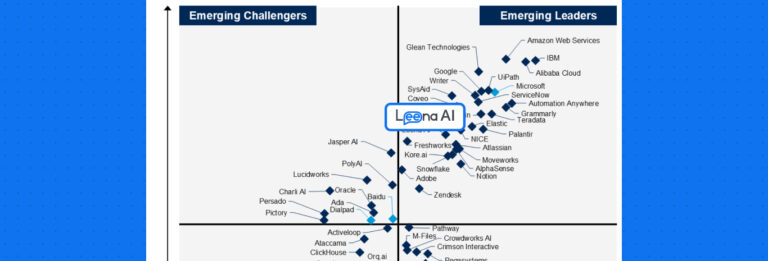Recruitment and onboarding are a constant concern for HR leaders. Get it wrong, and you lose out on talent quicker than you say, “You are hired”!
Long gone are the days when welcoming new hires meant providing them with a handbook illustrating company goals, job performance-related information, and a paperwork checklist. In this digital era, job applicants expect an effective onboarding program to acclimate to the culture.
While an employee onboarding program is not new to the business, organizations never paid attention to overhauling it to spruce it up. As a result, 28% of people leave their new jobs within 90 days of joining. It is a disappointing outcome: considering the time, resources, and money companies invest in sourcing, interviewing, and training recruits.
If organizations want to win the war for talent, they must design an automated, structured onboarding process that has technology at its heart. Transforming the employee onboarding experience brings many benefits to the business, extending far beyond the critical factor of employee engagement and retention.
To help you succeed, we have created a framework of the employee onboarding program that you can leverage for delivering a seamless onboarding experience to your new hires at every stage in their journey. Now it is up to you whether you want to impress or disappoint your new hires.
Note- It is vital for organizations to first understand the potential challenges that can arise while creating a formal employee onboarding program or during revamping the current process.
Potential challenges while creating an employee onboarding program
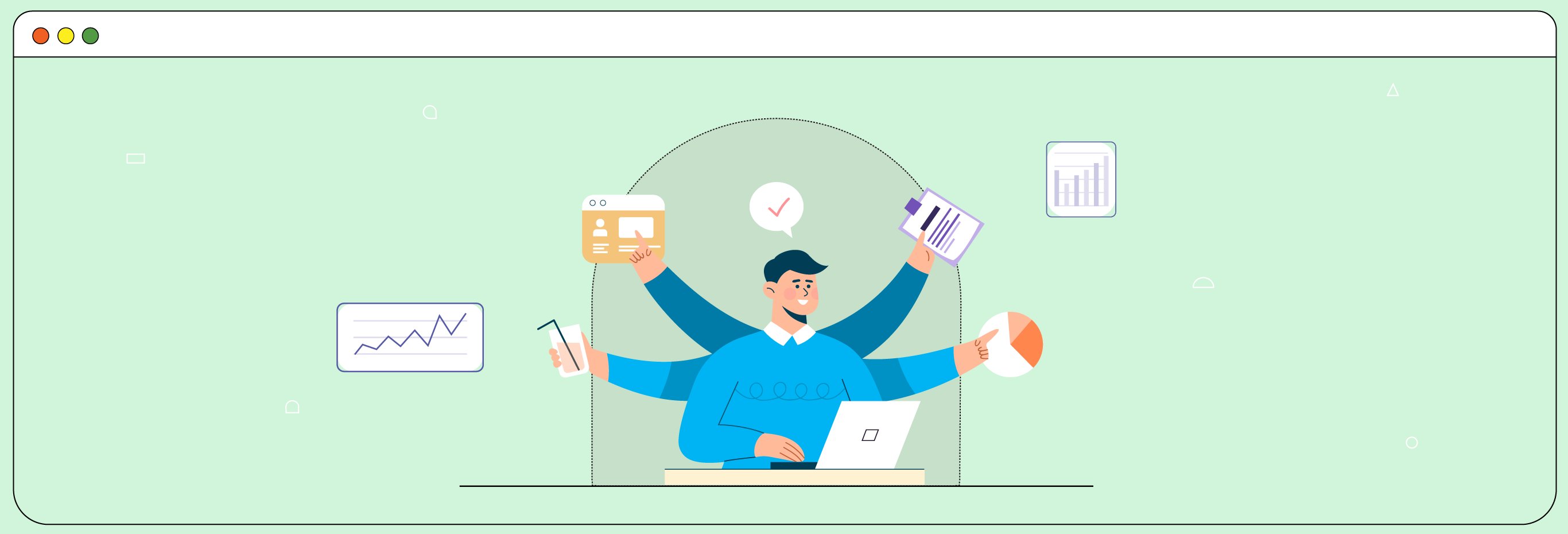
While there can be many challenges to address when developing a captivating employee onboarding program, it is better to be aware of them to ensure that your onboarding program is successful for your employees and the organization alike.
Lack of a structured program for HRs and supervisors to follow for onboarding new hires
One of the common issues that many organizations face during onboarding new hires is the absence of a structured onboarding program. Due to this, the new hires’ experience does not remain consistent, be it around the organization, unit, or job.
There are different ways an organization can formulate the onboarding procedure, but a certain level of uniformity is imperative to acquaint all the employees with the same information and experience as they gear themselves for their new roles.
While inconsistent onboarding practices might happen due to the fast-paced work environment, the ad hoc onboarding process can result in varied experiences for the new hires.
Such inconsistent experiences lower employees’ morale as they do not feel welcomed by their supervisors and HRs.
Ineffective implementation of the onboarding process across the organization
No matter how impressive your onboarding program is: if your supervisors and leaders throughout the organization do not embrace it fully, it will not fix the issue of inconsistent onboarding experiences.
Therefore, it is vital to include all the stakeholders in the development phase of these new onboarding practices. Incorporating their feedback while working on the solution will help HRs address the common obstacles they face when onboarding a new member in the organization. It will create a strong sense of commitment to these new practices.
No clear understanding of ownership of different onboarding tasks
Not knowing who is responsible for what during the onboarding of new hires is another challenge. With multiple steps involved, the organization must communicate the responsibilities of each team member involved in the onboarding procedure.
And since the process is not limited to managers and HRs and is rather dependent on other departments, all the team members should complete their duties within the given time frame. Else, the new hires will perceive your organization as a chaotic mess.
Lack of communication of the onboarding process to the new hire
Beyond communicating the onboarding responsibilities and process to managers and mentors, issues can crop up if the onboarding process is not explained to the new hire.
Articulating the onboarding process to new hires gives them a comprehensive understanding of their integration into the organization. However, a lack of communication can result in a loss of accountability as they will have no way of knowing if they are being onboarded appropriately or not without missing any steps.
It is not surprising for new hires to gradually realize that there are other organizational resources and information bases available that they were never aware of. It can affect their ability to work effectively and productively.
Lack of tools to evaluate the effectiveness of the onboarding process
A common inadvertence that often transpires after creating and implementing a new and improved employee onboarding program is not analyzing its efficiency.
Every new hire has a unique experience during the transition to a new organizational culture. Feedback becomes instrumental in enhancing the onboarding process and maintaining its effectiveness.
However, if there is a disconnect between HR and management after implementing the new onboarding process: it can lead to the loss of valuable information and feedback from the managers and leaders who perform these onboarding steps with new hires from start to finish.
Therefore, a mechanism is required to collect their feedback to get an accurate picture of the onboarding experience of new hires.
To avoid these common pitfalls, there are a few steps organizations should follow when developing and implementing new and improved onboarding procedures. By involving all stakeholders and investing time, and resources in developing and implementing the employee onboarding program, organizations can accelerate the process to make new hires productive.
How to successfully build and implement an effective employee onboarding program?

Just as how the first impression of people is important or how an experience with a new thing turns out impacts our future perception of it; the onboarding process is a real game-changer for an organization to portray why it is the best place to work for an employee and accustom him/her with the organization and help him/her identify with its goals and vision.
This section gives you a detailed walkthrough of the steps necessary to create a successful onboarding process, vital for companies who are thinking about introducing a formal employee onboarding program or are looking to improve their current process.
Assemble a team of HRs and hiring managers across departments
The onboarding process can vary for every organization depending on its size, structure, and designation. Sometimes, HR carries out the process with little to no input from anyone else. At other times, it is a group effort with managers, HR, and co-workers, all involved.
The most impactful onboarding is a group effort that brings together all factions of your business.
You can start the process by involving employees having varied perspectives on the onboarding process. Include members from the HR team, leadership, and management, especially those keen on transforming your current onboarding process. Take feedback from the recently hired employees. Their fresh experience will provide you with rich data on what worked, what did not, and what was missing during their recent onboarding program.
This consolidated information will give you a holistic perspective of all team members on the onboarding process. Ensure that you address the shortcomings of the current program and take into account the new ideas from all levels of the organization.
Determine the “what, how, who, and when”
Once you have created your onboarding team, the next step is to decide collectively what information the new employee needs, who is best to deliver that information and in what format, and when in the onboarding process each function should occur.
-
What
To figure out what needs to be included in your employee onboarding program, conduct a brainstorming session to accumulate everyone’s ideas as to what information and activities are important for new employees to succeed.
You can begin at the organizational level, move to the department level, and finish at the job level. You can use the following questions to figure out the critical elements-
- Will this help new employees acclimate to the new work environment and become productive faster?
- Will new employees feel better connected and informed?
- Will new employees easily align themselves or their jobs more clearly with the organization’s goals and objectives?
As part of this effort, you can consider rolling out a simple survey to employees hired within the past year to find out what was helpful, what was unnecessary or shared with them too soon, and what additional information or activities would have helped them familiarize themselves with work quickly.
Although the content of your employee onboarding program will be unique for your organization, there are some standard items you will want to include, such as-
- Mission, vision, and values of the organization
- Purpose of the department/team
- Peer names and their specific responsibilities
- What to expect on the first day of joining
- Employee preferences list
- Employee benefits training
- Sexual harassment prevention training
-
How
Once you have frozen the content of your program, determine the optimal delivery method for each segment. Employ a bevy of methods so that new employees don’t feel overwhelmed with knolls of mind-numbing memos, informational sheets, forms, and policies.
Think out-of-the-box for your employee onboarding programs, such as the use of videos, group meetings, one-on-ones, FAQs, electronic bulletin boards, and even phone calls to impart knowledge to new employees prior to day one.
Several enterprises use AI-powered virtual assistants to impart knowledge to new hires in an interactive manner without overwhelming them. These virtual assistants are equipped with natural language processing (NLU) and machine learning (ML) to help HRs focus on delivering a superior employee experience without worrying about administrative tasks.

-
Who
Decide who is the most appropriate person to provide the specific information or perform specific tasks.
Ascertain that the HR or the managers are not assigned everything. Rather, use this as an opportunity to let new hires connect with other employees- both within their new department and in the organization.
Introduce a buddy system in your program. The assigned buddy should help new hires tremendously in the acclimation and assimilation processes. Ensure that the buddy is a great supporter and ambassador of the organization. It is better to have someone as a buddy from the same department as the buddy is already familiar with the policies, procedures, and cultural norms of both the organization and the team.
Don’t forget to include top leadership during the onboarding process. You can conduct an all-hands meeting once a month or once a quarter where all new hires hear from the top-level executive and from some or all department heads.

When-
Your onboarding program will not run for a day or one week, but for six months at least. It is recommended to break the onboarding journey into five phases-
- prior to day one
- day one
- first week
- first month
- first six months
This part of your planning requires discipline as sometimes managers, HR, or even the buddy tend to share way too much, too quickly. Foretell your hiring managers to adapt their parts of the onboarding process to the experience level of new hires. Those who have a good amount of experience can be given more information earlier than others, but it is still essential to not overwhelm the new employees with large project loads too quickly.
-
Prior to day one
Remember that the onboarding begins right from the day the candidates sign the offer letter. It is the first stage where you can leave a positive impression on new hires and ascertain that they have made the right decision to join your organization.
You can do so by giving them a brief idea about what they can expect on their first day and the first week in the office. Ask everyone- HR, supervisor, and the assigned buddy to be friendly and welcoming over calls and emails. The new hire will be at ease after knowing whom to ask for help when they join, and what to plan for on the first day.
Another critically important element of the first phase of your onboarding process is to check that all the required resources and equipment are set up.

-
First day
The first day of a job is stressful and induces anxiety in new hires. When the brain is under stress, its ability to consume information is limited. So, it is better to plan the day well and avoid information overloading.
Avoid sharing long forms and benefits explanations on the first day. Forms, benefits, and compliance orientations can wait until the later first week. As the new hire is excited to join the organization and a team, keep that enthusiasm with an interesting and non-stressful day.
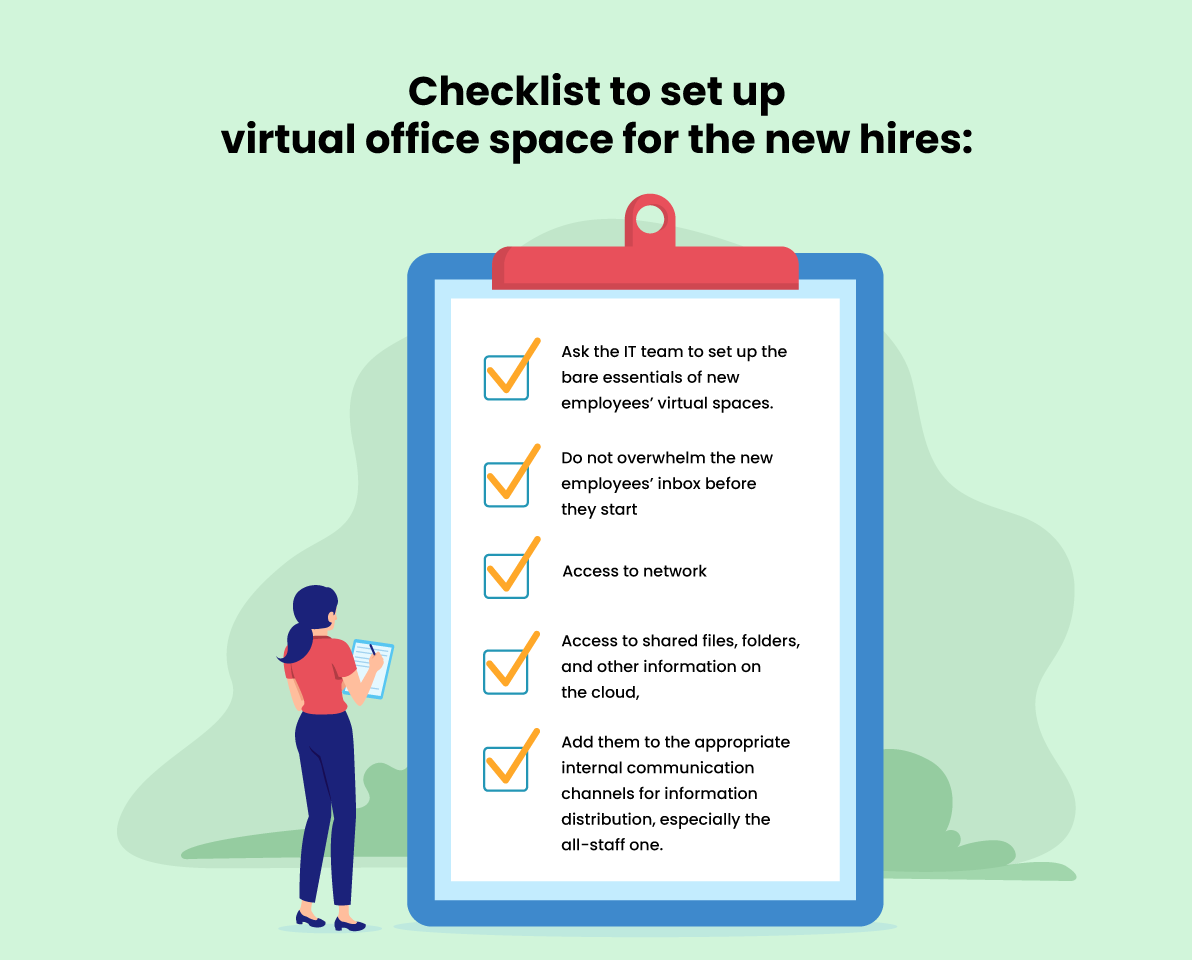
Introduce the new hires to their team members and other critical contacts to facilitate their seamless acclimation to the workspace and new tools. Their assigned buddy should meet them first to acquaint them with what needs to be done.
-
First week
In the first week of onboarding, new hires can interact with employees of those departments with whom they will have regular interactions. The supervisor can begin by familiarizing them with their role and associated expectations, as well as giving them meaningful work.
The supervisor should also connect frequently with the new hires and give them the opportunity to ask as many questions as possible.

-
First month
After the first week, some specific onboarding tasks become less frequent. The focus shifts to training and ongoing support and check-ins by both the buddy and the supervisor.
The amount and frequency of check-ins depend on the individual and his or her confidence and experience level. HR should also check in informally with the new hires at the end of the first month to learn how things are going. Asking them the top three things they like about the job and the top three challenges they face can help organizations yield information in further improving the onboarding process. The conversation with HR also gives employees the impression that they have an additional support base.

-
First six months
Following the first month, check-ins should increasingly include feedback, while still offering support and guidance. The buddy should stay involved as well, although his or her role will likely diminish over time.
At the end of six months or thereabouts, administer an anonymous survey to all those who were hired around the same time to learn what has been effective and what can be improved.

Implement each step in the onboarding process
Developing a checklist that lays out all the steps for each different stage of the onboarding process from day one through the new hire’s first six months is necessary for effective implementation. This checklist should be an easy-to-use tool for managers, supervisors, and human resources to assist them with onboarding new hires in a high-paced work environment.
This checklist should detail all the onboarding steps to ensure that new hires receive all the training related to their job duties, organization background, and other information, such as benefits, security access, et al. It should also list out who needs to complete which step and when the step needs to be completed.
You should consider the different types of staff, that is, entry-level clerical, senior professional level, management, etc., within the organization to tailor these programs accordingly.
The onboarding checklist should be supplemented with an automated system to set reminders and create a system of accountability. The automated system can be an integrated HR service management solution with the appropriate capabilities or as simple as an onboarding module to notify the appropriate employee when a step needs to be completed.
Read “Five reasons why you should invest in employee onboarding software” here.
Remember that the goal is to provide a great experience to the new employees, and using the automated tools means there is no scope to omit something that is important and everything is in place.

Assess the success of your onboarding program
Putting forth the time, resources, and people needed to develop and implement the best employee onboarding program is a significant step in the right direction. However, it doesn’t end here. Organizations and individuals alike are constantly evolving in the fast-paced and pandemic-induced environment. And for this reason, it is critical to evaluate the employee onboarding program constantly to maintain its effectiveness.
The most impactful way to execute this is to solicit feedback from those who are involved at various checkpoints in the process and beyond.
Create an onboarding evaluation survey and roll it out to new hires after they have completed their first six months. These surveys should contain questions that evaluate each phase of the onboarding program- right from the application process.
This will help you determine whether each step was performed and its level of effectiveness in meeting the objectives.
If possible, make the surveys and their results anonymous as this will help you gather honest and objective feedback from the new hires.

How introducing an employee onboarding program will maximize your business success
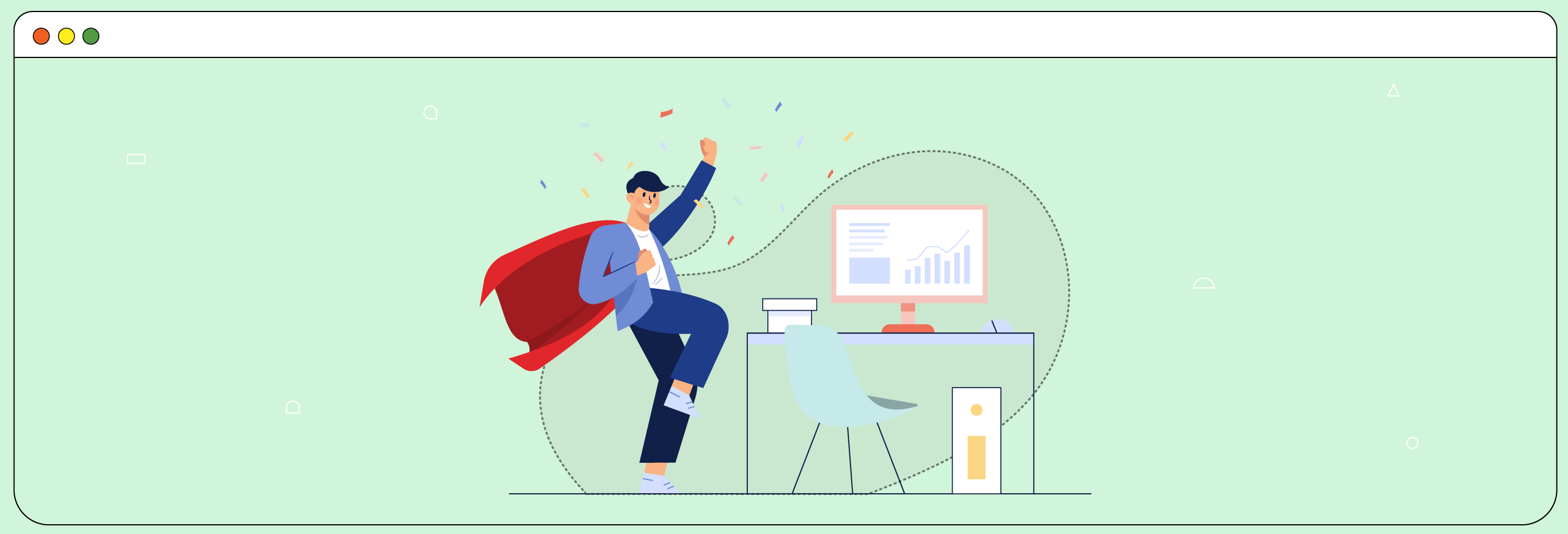
Know how creating and implementing an employee onboarding program will impact your business-
Shoots up the productivity of new hires
Your onboarding program’s effectiveness sets the pace forward for your new employees’ productivity. While a constructive onboarding plan increases 70% the productivity of new hires, having no onboarding plan in place leads to low employee morale and poor engagement levels.
New hires find it challenging to acclimate themselves to the remote work environment and build peer connections across departments. However, with the right employee onboarding program in place, new hires acclimatize swiftly to the organization, feel confident and motivated about their work since Day 1, and ensure greater productivity by 70%.
An onboarding program includes other actions too, such as goal setting for new employees, frequent manager check-ins, and employee development plans, to keep them informed about what is expected of them, where they stand, and further steps to improve.
Higher retention rate
Employee retention has been one of the most indispensable priorities for companies, especially after the great resignation economic trend. Employee turnover, including the cost to backfill the position and the cost of vacancy, has proven usurious to organizations.
While some turnover is always anticipated, organizations always look forward to maximizing their employees’ lifetime value. Replacing a new hire within 90 days of employment is a more time-consuming and costly fallout than replacing a more tenured employee who has been in the company for years and has delivered great results.
Research by Glassdoor has shown that employees who rate their onboarding experience as highly effective are 18 times more likely to feel highly committed to their organization.
Organizations that focus extensively on their onboarding process increase the retention of new hires by 82%. Such organizations start engaging with employees the moment new hires sign the offer letter.
Organizations that want to retain talent should focus on welcoming their new employees warmly to ensure their smooth transition from candidate to a new hire. Do away with the paperwork to fill your new hires’ first day with the celebration, introductions, and early learning. Then carry out your onboarding process for at least 90 days to ensure new hires have settled in their roles and stay long-term.
Increases employee engagement
Employee engagement impacts every aspect of the employee lifecycle. From hiring to onboarding and offboarding, your employee engagement practices can make or break the brand.
As per research, engaged employees deliver higher productivity and profitability and lower absenteeism and turnover. However, the irony is that only 33% of employees feel engaged.
Onboarding new employees thoughtfully make them feel more connected to your organization, its mission, vision, and values. Facilitate conversations between your leaders and new employees to make them feel a vital part of your organization. It gives employees assurance that they are valued, and their personal development also matters to the organization. Organizations should educate new hires about the benefits of being a part of the business and how their contribution can ensure its success.
Attracts new talent
Twenty percent of new hires are unlikely to recommend your organization to a friend or family member if they have had a poor onboarding experience. Things exacerbate when employees express their opinions on public forums and review sites, like Glassdoor. It tarnishes your brand as an employer.
Therefore, creating an engaging onboarding experience has become a pressing priority to deliver a stellar employee experience. It helps you retain talent and attract high-performing candidates with relevant skillsets.
Once you have provided a top-notch onboarding experience to your new hires, ask them to write you a preliminary review on Glassdoor. Keep your new hires looped in your employee referral program to get talent recommendations from within their networks.
Employee referrals are faster, less expensive to hire, and stay longer, making it an attractive channel for sourcing the appropriate candidates.
Shortens learning curve
A new hire takes approximately eight weeks to reach the highest productivity. That’s a long time. With a formal structure and relevant training material in place, onboarding can trim down this time significantly.
An effective and accelerated process ensures a more productive learning curve. As a result, employees demonstrate their value to the company faster. Studies show that employees who undergo extensive onboarding programs gain complete proficiency 34% faster than those in shorter ones.
Reinvent employee onboarding process or lose talent – Choice is yours
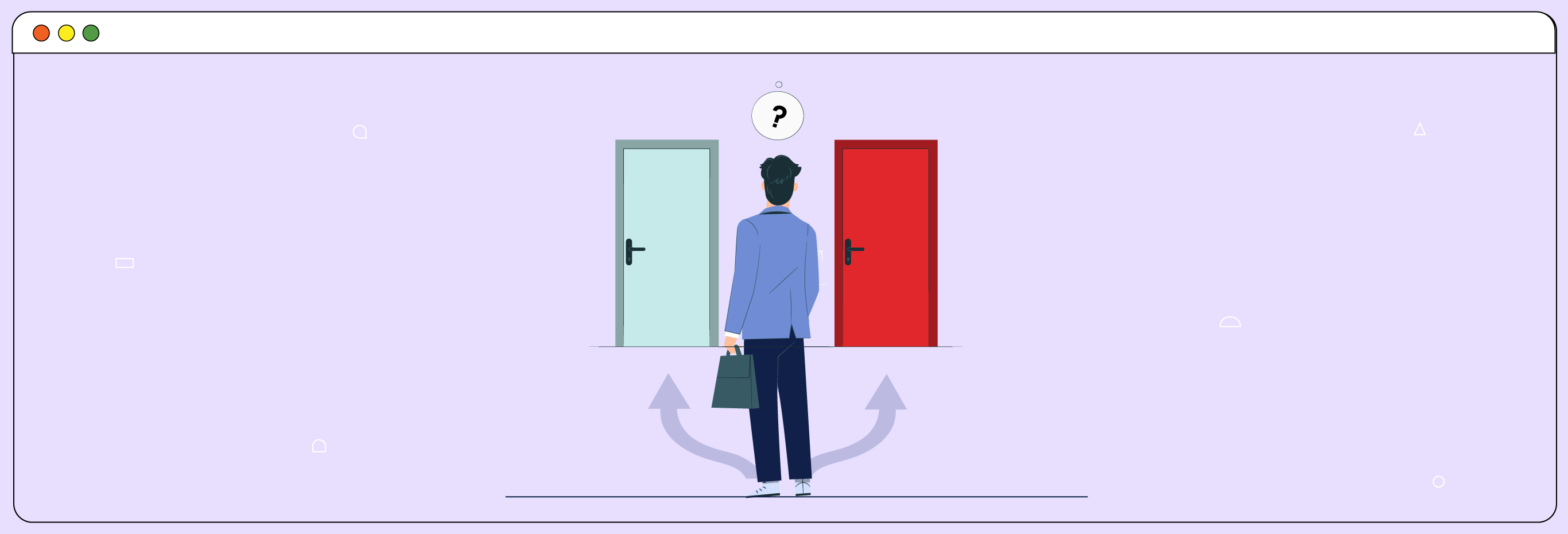
There is a lot to think about and do with regards to finding the best way to let new employees become productive faster, increase engagement, and ultimately improve retention.
An automated onboarding process is one of the best ways to achieve the same and leave a good impression on employees from day 1. The automatic onboarding process ensures new hires spend less time buried under paperwork and use more time towards understanding the organizational values, interacting with colleagues, and exploring the work culture.
An incremental and iterative onboarding process can make all the difference in attracting the new ones and keeping the good ones for a long time. By following the steps outlined and watching out for the pitfalls, you can tailor a program specifically to your organization’s needs and culture.
At Leena AI, we provide our clients with a clear picture of what their business’ overall onboarding process should be. We help them with getting each step right and that’s what makes them achieve a successful employee onboarding and engagement process in the long term. Connect with our experts today to know more!








